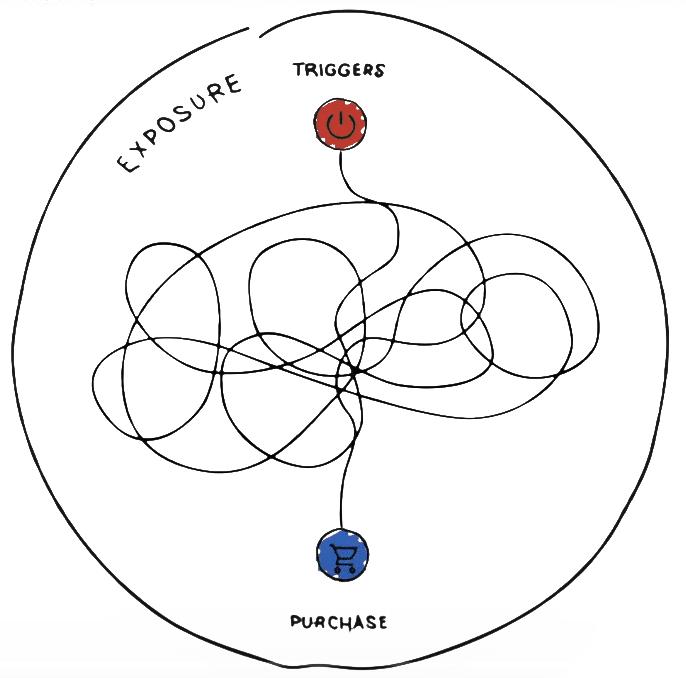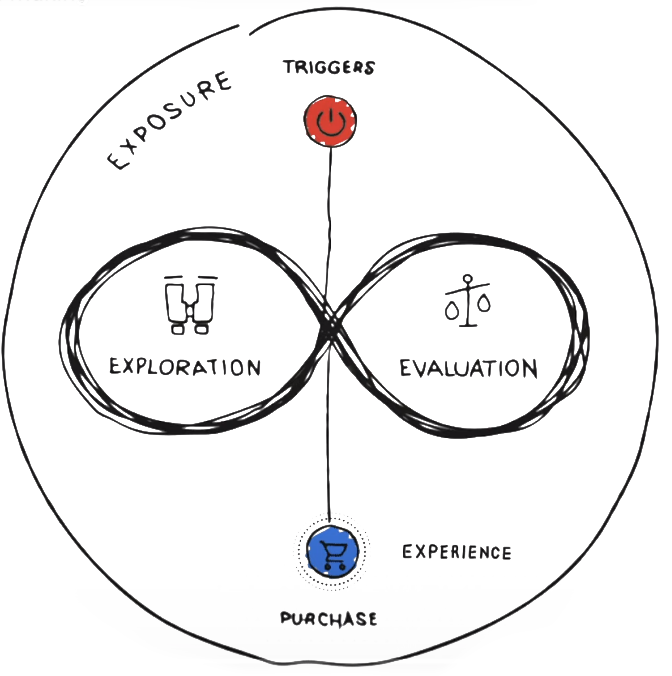Consumer Shopping Behaviour Study - The Messy Middle (Part 1)
Table of Contents (Click to show/hide)









Consumer Shopping Behaviour Study
The Messy Middle
Human beings love to think of themselves as rational operators, real logical thinkers – especially when it comes to making decisions about spending our hard-earned money.
That dig a little bit deeper beneath the surface and you’ll find, just like Google researchers Alistair Rennie and Jonny Protheroe just uncovered, that nothing could be further from the truth.
Masterful sales people, persuaders, marketers, and influencers have long understood that human beings are wired to respond emotionally first, later backfilling that decision with as much logic as we can muster in an effort to rationalise why we’ve made the decisions that we have.
Experts in the field of persuasion, influence, and salesmanship today looking at consumer behaviour has started to call this new insight into why we buy the things we buy "The Messy Middle". These experts recognise that our decision-making when it comes time to buy something is anything but cut and dry, anything but linear, and (almost) never driven by logic primarily.
Logical reasoning often gives away to our emotions, so we end up making decisions that surprise even ourselves. What matters to you at a purchase moment, rather than your loyalty to a brand, the "free offering package" may value more. Consumers explore, compare, and evaluate multiple options before making a decision, and they're influenced by countless things along the way.
This makes the space between awareness and purchase intricate and complex so much so that we've named it "The Messy Middle" and spent the past two years researching it to help brands navigate it. - Google
Logic vs Emotion – Our Decision Making Muscles Aren’t What We Think They Are
In the early days of e-commerce, the pioneers of online shopping essentially set up their sites as a way to provide customers with an opportunity to compare prices of what they have to offer versus what brick and mortar shops provided.
Online business empires in the early days were built on the back of these price wars, helping customers find better prices (usually available because the economies of scale that online businesses provided, without having to worry about the overhead brick and mortar operations contended with) – and most people were more than happy to shop online almost exclusively because of these great deals.
Today, however, low prices maybe a slight competitive advantage in the online landscape, but there are a lot of other pieces that consumers choose to buy from one company or another – including from companies they’ve done business with in the past and enjoyed, as well as businesses that are complete and total strangers to them, up until they handover their credit card information and click the order button.
- On average, behavioural biases in "The Messy Middle" caused over 60% of consumers to abandon their preferred brand for a brand they'd never heard of.
- When researching products online, 1 in 3 consumers will choose their second choice brand over their first choice because it shows up on the search page.
- Offers like free shipping are appealing because the idea that something costs nothing has a huge effect on people's decision-making:
- Between March and June, search interest in "free delivery" spiked across Australia, with search interest in terms like "booktopia free delivery" and "uber eats free delivery" rising up to 150%.
Researchers have been trying to figure out what goes into the buying decision making process for decades and decades, and the only thing that experts really agree is that the process is anything but linear and that there is a highly complicated intertwining web of different and often times competing thoughts that push people in one direction or another.

Because every human experience is unique there’s no “one-size-fits-all” pastor key to unlock this puzzle, but that doesn’t mean that there aren’t ways to stack the deck in your favour as a business owner, marketer, or advertising by recognising and strategising around The Messy Middle.
Understanding the Messy Middle
Exploration & Evaluation are the two critical components in that messy shopping journey,

One of the easiest ways to understand the concept of The Messy Middle is to look at two popular search terms regularly associated with internet users looking to find something they want to purchase: “cheap” and “best”.
When someone searches the term “cheap” associated with an item they are looking for they almost universally mean that they are looking for something inexpensive, affordable, and something that isn’t going to break their bank accounts. There isn’t a lot of variance in what they are looking for, and there isn’t a lot of ambiguity.
When someone is searching for the “best” items of a specific, though, there’s nothing but ambiguity infused in that search.
The best shoes, for example, may mean something entirely different to a ballerina than they do to a marathon runner than they would to a basketball player – even millions of web searches are conducted each day looking for the “best shoes”.
It doesn’t matter if someone is looking for a “cheap baseball bat” or the “best shower head”, the concept of The Messy Middle is universal. Understanding this kind of consumer psychology is a huge piece of the puzzle to success today (especially is so much business moves online).
Researchers like the pair at Google are focusing around a handful of core elements that help make up the decision-making necessary for consumers to navigate The Messy Middle, with the entire approach beginning with exposure and triggers that initiate the decision-making process.
After an individual has become exposed to a product, they are interested in or have been triggered into thinking about buying a specific product. They then go through(simultaneously) an exploration of their options and an evaluation of those options.
The process rinses and repeats as much as necessary until a purchasing decision has been made – but there are a variety of different things (especially different cognitive biases) that influence what that final decision will be.
Some of these biases include, but aren’t limited to:
… And that’s just the tip of the iceberg, really. I picked two that marketers often overlook:
Brand Presence
Simply being present during the exploration can drive behaviour.
When a customer starts exploration, especially on search. Your brand will immediately become a part of the consideration as long as your brand is present. Ensuring brand presence and keeping your business, products, or services “top of mind”is of huge importance. Direct response marketing will always be of value, but brand marketing these days (especially multi-channel marketing) can help boost your bottom line as well.
Social Norms and Authority Bias
Furthermore, reviews and the "rule of thumb" are the shortcuts that accelerate and simplify the purchase decision. Customer adopts the opinions and follows the behaviours of the majority. In this digital age, the internet subconsciously amplifies the power of information such as social proof, reviews and the 5-star rating. With that mind, it's no hard to think about the power of credible, knowledgeable experts leads.
The Future of Consumer Shopping Behaviour and Why It Matters So Much
For marketers to succeed in today’s super-competitive business landscape, they not only have to recognise the importance of The Messy Middle, but they also have to strategise around this important part of the consumer experience
Finding a way to make your proposition as compelling and as “instantly gratifying” as possible is equally as important. The more space and time between your customer purchasing something and then receiving the deliverable – whatever that may be – the less compelling, the less attractive, and the less effective your proposition becomes.
These are just a handful of the ways you’ll want to market when targeting The Messy Middle. Still, all of them can be implemented ASAP for outsized results. Build on those results moving forward, and you’ll be able to outflank competitors that are still trying to win sales and marketing arguments based off of logic alone.









